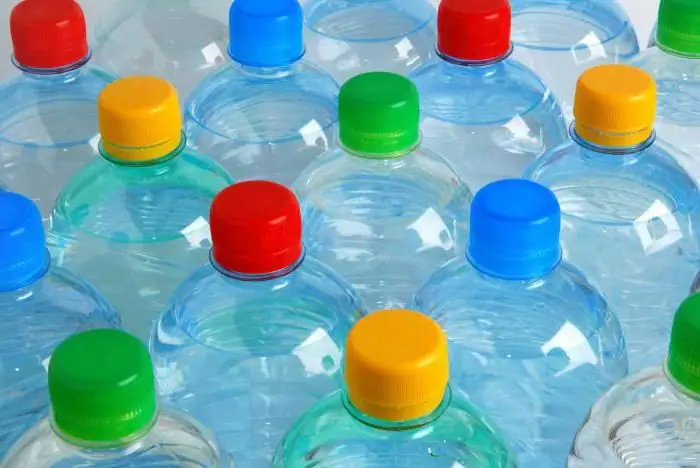2026 Author: Howard Calhoun | [email protected]. Last modified: 2025-01-24 13:10:43
Recycling of plastic bottles is one of the ways to use recycled materials to renew the resource base of polymeric materials. During processing, the problem of waste disposal is solved, and materials are obtained that can be re-used for production, even taking into account some restrictions (technological, hygienic, legislative, sanitary) associated with the reuse of polymers.

Due to the fact that polyethylene terephthalate (PET) has fairly stable mechanical properties, the processing of plastic bottles from it is the most proven and established way of using polymeric secondary raw materials. There are two main types of recycling - mechanical and chemical. As a rule, in most cases, the processing of PET bottles is carried out mechanically, since the chemical process imposes increased requirements on raw materials, and the use of expensive catalysts is necessary. With the mechanical method, plasticization of waste is not required. PET bottles are first sorted from other types of polymer containers(polyethylene, PVC) and foreign objects (plugs, garbage). Bottles can be sorted by color and even polymer type, depending on the requirements for the final product.

The initial processing of plastic bottles takes place at a knife crusher, where, as a result of the technological process, PET particles of 0.5-10 mm are formed. The resulting polymer crumb is washed with a solution of caustic soda or water, after which it is dried according to a certain technology at a humidity of 0.02-0.05% and a temperature of 130 ºС. The drying process is of great importance, failure to comply with the required parameters for humidity leads to an irreversible deterioration in the quality of secondary raw materials.
After drying, the material is agglomerated, as a result of which the crumb obtained at the previous stages of the technology is sintered into small lumps. At this stage, the recycling of plastic bottles may be completed, since the agglomerate can already be used as a raw material. In order to average the physical characteristics of recyclables, they produce granulation. As a result, the processed PET particles become denser, and the resulting material is easier to use in the future and obtain the necessary materials on standard equipment.

The main uses of raw materials from PET waste are the production of films, fibers and bottles. As a rule, taking into account the mechanical and rheological (material flow) properties of PET recyclable materials, it is used for the production of containers for various chemicals. ATrecycled PET is not used as food packaging. Recycled polyethylene terephthalate fiber is most often processed into woven bases for carpet and clothing or textiles. Recycled materials are also used for the manufacture of geotextiles, synthetic winterizers, noise-insulating materials, absorbent and filter elements, electrical products, fittings (by casting), automotive parts.
Recommended:
Polyethylene - what is it? Application of polyethylene

What is polyethylene? What are its characteristics? How is polyethylene produced? These are very interesting questions that will definitely be considered in this article
What is a plastic bottle made of, interesting to know?

It all starts with getting plastic. It is made from oil. The latter is loaded into containers, onto tankers and sent to factories. Sometimes bioplastics made from plant materials are used
Life and he alth insurance. Voluntary life and he alth insurance. Compulsory life and he alth insurance

To insure the life and he alth of citizens of the Russian Federation, the state allocates multi-billion sums. But far from all of this money is being used for its intended purpose. This is due to the fact that people are not aware of their rights in financial, pension and insurance matters
Recycling plastic bottles as a business. Plastic Bottle Recycling Equipment

Now there are many business ideas that improve the lives of the population. If bottle recycling becomes popular among people, then it will be possible to create a permanent source of income. In our country, few people are engaged in such activities, so there is a possibility of profitability
Killing two birds with one stone: plastic bottle recycling

Recycling of plastic bottles today is perhaps one of the most important problems. If this is not done, in a few years we will be swallowed up by mountains of garbage. And you can build a great business on it

